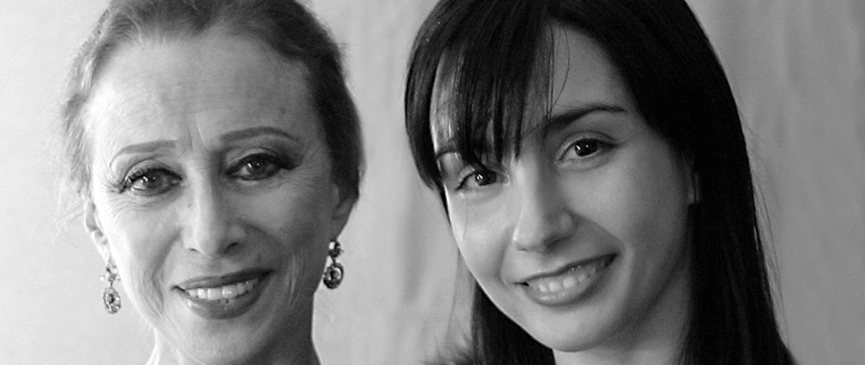Main content
Maya Plisetskaya & Tamara Rojo Prince of Asturias Award for the Arts 2005

For their exceptional careers in the world of dance, where they are acknowledged as representing the pinnacle of expressionism in their respective generations.
Maya Plisetskaya (Moscú, URSS, 1925 - Munich, Germany, 2015), considered one of the twentieth century’s greatest ballerinas, has achieved the most prestigious that an artist of this specialty can achieve: “Prima ballerina assoluta”.
Born in Moscow in 1925 and a nationalized Spaniard since 1993, Maya Plisetskaya set out in the world of dance at the tender age of three. In 1934 she joined the Moscow School for Dance and at the age of eighteen graduated from the Choreography School of the Bolshoi Theatre, which she went on to join just months later, and where she rose to become prima ballerina. She began her professional career there dancing in “Swan Lake”. Plisetskaya was considered the stage’s most dynamic ballerina since Ana Pavlova, and an exponent of classical dance. The critics themselves have acknowledged her dynamic personality and unique personal style. From the outset she was dubbed “The Queen of the Air” . “Swan Lake”, which she danced for the first time in 1947 and repeated over 800 times, is outstanding among the many works she interpreted on stages around the world. Such is her versatility that she has been able to interpret such characters as Tzarina in “The Fountain of Bakhchisarai”, the perverse Kitri in “Don Quijote” and the heroic Laurencia in the ballet of the same name. In 1967, she premiered “Carmen” and in 1972, “Ana Karenina” with a score written by her husband, the composer and pianist Rodion Shchedrin. Plisetskaya took on the roles of set desginer and choreographer in this latter production. In 1973, Roland Petit composed “La rose malade” for her and some years later Maurice Béjart did the same with “Isadora”. She directed the Opera Ballet of Rome and, between 1987 and 1990, was director of Spain’s National Lyric Ballet Company. In 1994 she founded the Russian Imperial Ballet, as well as presenting her memoirs in Moscow, entitled “I, Maya Plisetskaya”, since translated into fourteen languages, including Japanese, German, Italian and Serbian. In 2000, she and her husband founded the International Maya Plisetskaya and Rodion Shchedrin Foundation in Maintz, Germany, to conserve, document and facilitate access to the artistic work of them both.
The USSR’s People’s Prize (1959), Paris’ Ana Pavlova (1962), the Lenin Prize (1964), the French Legion of Honour (1986), Spain’s Gold Medal for the Fine Arts (1991) and her country’s highest accolade, the Medal for Service to the Russian State, which she received twice (1995 and 2000), all figure outstandingly amongst the distinctions she received. She also been awarded honorary doctorates by Moscow’s Lomonosov University and the Paris Sorbonne.
Tamara Rojo (Montreal, Canada, 1974) was born to Spanish parents and holds Spanish nationality. Prima ballerina of the Royal Ballet of London since 2000, she has been artistic director of the English National Ballet since 2012.
She took her first steps in the artistic world at the Victor Ullate Dance Centre (1983 - 1991) and completed her training under David Howard and Renatto Paroni. After first working with the Ullate Company (1991 - 1996), her career became international under the aegis of Galina Samsova, who invited her to join the Scottish Ballet (1996 - 1997). Amongst other works, she danced “Swan Lake”, “The Nutcracker Suite” and “Romeo and Juliet” with this company. She went on to become the English National Ballet’s prima ballerina (1997 - 2000), and then joined London’s Royal Ballet at the invitation of Sir Anthony Dowell in July 2000 in the same position, thereby becoming the first Spaniard to be a member of the United Kingdom’s premier company and one of the most prestigious in the world. She was also the youngest artist in the history of ballet to become prima ballerina. She has performed with Milan’s La Scala Theatre Ballet, the Opera of Nice Ballet, the Arena of Verona, Cuba’s National Ballet and the Berlin Opera Ballet, as well as taking part in numerous international galas. From the beginning of her career, Tamara Rojo has performed roles that present numerous nuances, each one hallmarked by the enormous maturity of her performing art. Her neo-classical choreography of the Dutch School and Ullate’s deeply Spanish-inspired choreography, seen in such works as “Volando hacia la luz” (Flying towards the Light) and “Concert for Three”, are outstanding, as also is the revival choreography of Derek Deane in works such as “Romeo and Juliet”.
Her career has been graced with a range of accolades, including the Gold Medal and Jury’s Award at the 1994 Paris International Dance Competition, which she won at the age of barely twenty, the Italian Critics’ Award (1996), the accolade of Ballerina of the Year from the Times of London and Spain’s Gold Medal for Merit in the Fine Arts (2002). In 2001, she received the National Dance Awards’ Best Ballerina Award from UK’s Critics’ Circle. In 2004, she won the “Leonid Massine” Positano Award for Valour and was appointed Ambassador for Denmark’s Hans Christian Andersen Foundation. She received the Laurence Olivier Award in 2010, was invested Commander by Number of the Order of Isabella the Catholic in 2011 and was awarded the Gold Medal for Fine Arts by the John F. Kennedy Center for Performing Arts in 2012.
End of main content
